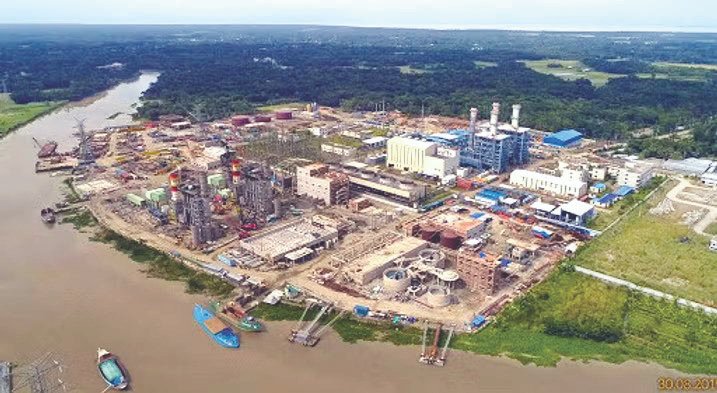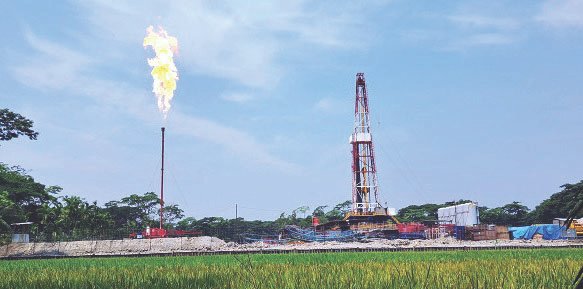
Bangladesh’s gas supply chain has been struggling with a chronic deficit for the past four to five years. The coincident peak demand of connected end users is estimated at 4,200–4,300 MMCFD. However, according to Petrobangla’s daily production report, supply during 24 hours between September 28 and 29 was only 2,809.20 MMCFD. This figure includes 1,041 MMCFD of imported RLNG, while production from the rapidly depleting domestic fields connected to the national grid stood at 1,768.20 MMCFD.
Additionally, the Shabazpur gas field, which is not linked to the grid, currently produces 72 MMCFD for local use in Bhola. Gas reserves at Bhola, discovered by BAPEX in the mid-1990s, remain stranded due to the absence of a transmission pipeline connecting them to the national grid. The Bhola reserves have also not been professionally assessed.
In the late 1990s, US energy giant UNOCAL, under its proposed Western Region Integrated Project (WRIP), declared its plan to develop Bhola’s gas prospects at its own risk. The project included building a 20-inch, 120-kilometer cross-country pipeline from Shabazpur in Bhola to Digholia in Khulna, along with power plants of 60 MW in Bhola, 100 MW in Barishal, and 300 MW in Khulna. Petrobangla and UNOCAL negotiated agreements covering PSC, GPSA, GTA, and IA. The teams jointly surveyed a pipeline route that crossed three major tidal rivers and multiple waterways, and the right-of-way (ROW) was finalized. The project’s estimated cost was $700 million.
Had the government approved the project in 1999, Bhola’s gas could have provided supply security to the Barishal and Khulna regions by 2005. Many industries in Jashore and Khulna could have survived, and new agro-based industries could have developed. Moreover, the construction of a controversial imported coal-fired power plant near the Sundarbans mangrove forest could have been avoided. Unfortunately, the government withdrew at the final stage of negotiations, leaving Bhola’s gas stranded.

Although a transmission pipeline was later built from Ishwardi to Khulna via Kushtia and Jashore, it remains largely unutilized. The Awami League government (2009–2024) attempted several initiatives to evacuate Bhola’s gas but failed due to a lack of clarity and commitment from Petrobangla and the EMRD. A controversial decision to convert Bhola gas to CNG for industries in Dhaka also failed to meet its objectives.
There were hopes that the interim government, free from political ambitions, would make a firm decision on connecting Bhola gas to the grid. Instead, it hesitated, weighing the costly option of a transmission pipeline against setting up an LNG plant at Bhola to transport LNG to demand centers. Typically, LNG plants are built at stranded onshore or offshore gas resources only when building a transmission pipeline is technologically infeasible. LNG projects require at least 3–4 TCF of proven reserves to justify the $2–3 billion investment. In contrast, a transmission pipeline connected to the grid can serve throughout its operational life.
From nearly 50 years of hands-on experience as a pipeline engineer in South Asia, Central Asia, and Australia—and from direct involvement in WRIP—I can confidently state that a pipeline from Shabazpur to Khulna via Barishal is entirely feasible. Even today, there is a ready market for 150–200 MMCFD of gas in the greater Khulna and Barishal regions. Yes, crossing large tidal rivers like the Tetulia and Meghna is challenging, but at least a dozen reputable US and European companies could build the 120-km, 24-inch pipeline along a clear ROW within two years. Furthermore, the existence of such a pipeline would encourage IOCs to explore nearby gas blocks, knowing they could evacuate any discovered gas.
By contrast, an LNG plant would require proven reserves of 3–4 TCF and substantial risk-sharing by investors across resource, construction, and marketing fronts. While additional reserves may exist in the region, this must first be verified through professional assessment. The previous government’s interest in LNG was partly influenced by a US company, Excelerate, which proposed supplying RLNG from a floating LNG facility 70 km off Kuakata. In reality, this project would pose even greater challenges than building a pipeline from Bhola. Bangladesh’s experience with LNG since 2018 has already been bitter. If pipeline gas is available, Bangladesh should limit its dependence on LNG.
Recommendation
The government should immediately move to develop Bhola’s gas prospects through a professional reserve assessment. It should also revisit the earlier pipeline route from Shabazpur to Digholia and secure the ROW. If an international tender for constructing a 24-inch cross-country pipeline on an EPC basis is floated by June 2026, Bhola gas could begin supplying the Barishal and Khulna regions by 2030.
At the same time, BAPEX and IOCs should be allowed to conduct extensive exploration in Barishal and Khulna to identify additional resources. Policymakers must rely on experienced professionals, not opportunists or fortune-seekers. Enough time has already been wasted. Bangladesh cannot afford to let Bhola gas remain stranded while the national grid struggles for supply.
For perspective, Gazprom built thousands of kilometers of the Nord Stream pipeline from Russia to Germany, including large sections under the seabed. A pipeline from Bhola to the national grid, while technically demanding, is feasible with lay barges and swamp buggies—technologies local contractors have not yet used but are readily available internationally.
The sooner the government makes a decision, the better. People in the greater Khulna and Barishal regions must not be deprived of the benefits of Bhola’s pipeline gas any longer.
Download Special Article As PDF/userfiles/EP_SA_23_8.pdf



